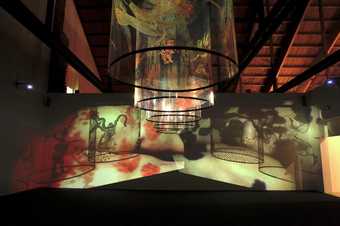9 rooms in Materials and Objects
Nalini Malani’s ‘video shadow plays’ combine video, shadow and sound to tell multiple stories. In this work, she creates a tribute to women’s lives forgotten throughout history.
Each cylinder in In Search of Vanished Blood is reverse painted and features images of dispossessed people, mythological figures and surgical instruments. They cast ominous shadows which shift across the projections.
The artist draws inspiration from a range of sources. We hear Cassandra, a figure from Greek mythology who predicts the future but is cursed, so no-one believes her. Referencing texts from German writers Christa Wolf and Heiner Müller, Indian writer and activist Mahasweta Devi, Irish author Samuel Beckett, and others, Cassandra anticipates violence against women during periods of political upheaval. Her story unfolds through stop-motion animations inspired by both historic and recent wartime atrocities.
The title of the work In Search of Vanished Blood is from the poem Lahu ka Surag 1965 by Pakistani writer Faiz Ahmed Faiz. Lines from the poem appear over Cassandra’s veiled face. People who have experienced violence reappear through the endless loops of recurring shadows, creating a sense of lost hope. The sequence ends with a gesture in American Sign Language that expresses a longing for democracy.
Malani’s work reflects her commitment to feminist activism. In Search of Vanished Blood amplifies women’s voices to express Malani’s belief in humanism – the strength of what we have in common rather than what divides us.

